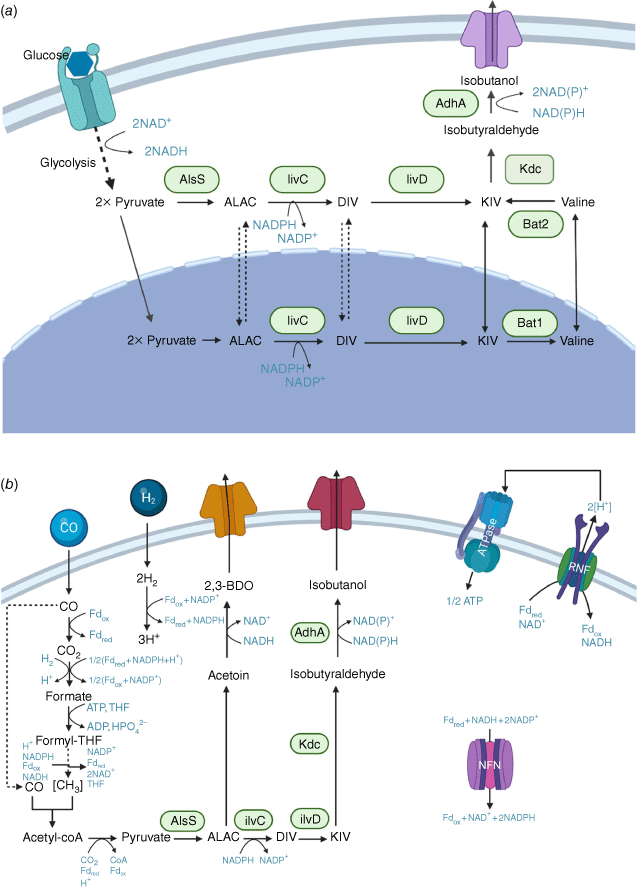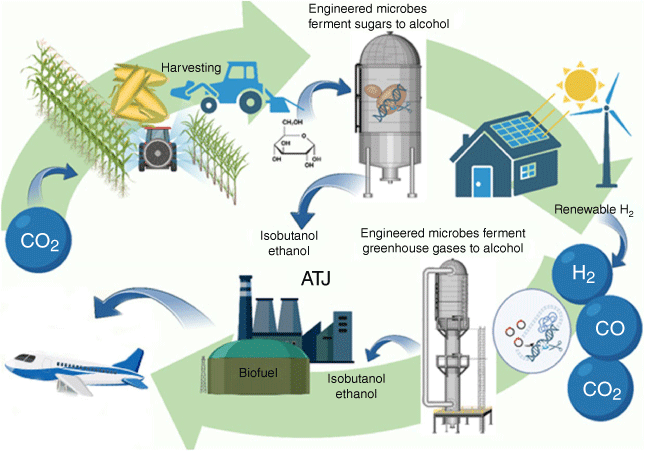Gas fermentation for microbial sustainable aviation fuel production
Karen Rodriguez A , Marcelo Pedroso B , Audrey Harris C , Shivani Garg C , Damian Hine D , Michael Köpke C , Gerhard Schenk B and Esteban Marcellin A *A Australian Institute for Bioengineering and Nanotechnology, The University of Queensland, St Lucia, Qld, Australia.
B School of Chemistry and Molecular Biosciences, The University of Queensland, St Lucia, Qld, Australia.
C LanzaTech Inc., Skokie, IL, USA.
D Queensland Alliance for Agriculture and Food Innovation, The University of Queensland, St Lucia, Qld, Australia.

Karen Rodriguez is a PhD candidate at the Institute for Nanotechnology and Bioengineering, The University of Queensland. In collaboration with Schenk’s group (The University of Queensland) and Lanzatech, she aims to use the CO/CO2 + H2-fixing bacteria, Clostridium autoethanogenum, to produce isobutanol, a next-generation biofuel. Throughout her PhD, she uses multi-omics analysis to better understand the native and recombinant acetogenic metabolism and further improve productivity. |

Marcelo Pedroso is a Postdoctoral researcher at the University of Queensland. His main research interest is in the field of enzymology. Particularly, he is interested in understanding structure–function relationships in enzymes, which integrates molecular and structural biology, enzyme biochemistry and spectroscopy to uncover and improve the reaction mechanisms catalysed by enzymes enabling the conversion of renewable feedstocks into chemicals that are green and environmentally friendly. |

Audrey Harris is a Senior Scientist at LanzaTech in Skokie, Illinois. She has worked in a variety of environmentally focused microbiology research laboratories and is interested in the potential of Synthetic Biology to solve climate and energy issues towards a more equitable future. |

Shivani Garg is a Project Manager in Metabolic Engineering group at LanzaTech. Her role at LanzaTech is to advance the fuels production platform by engineering anaerobic acetogens. She is deeply interested in development of technologies that enable sustainable production and commercialisation of fuels and chemicals. |

Damian Hine is an innovation economist who is Professor of Future Markets and BioEconomies in the Queensland Alliance for Agriculture and Food Innovation (QAAFI) at the University of Queensland. |

Michael Köpke is a pioneer in Synthetic Biology of carbon fixing microbes with over 15 years of experience in biotech. He has led several seminal studies, including providing a first genetic blueprint of anaerobic gas fermenting microbes and demonstration that these microbes can be reprogrammed for carbon-negative biomanufacturing of fuel and chemical products directly from CO2, industrial emissions, or municipal solid waste. |

Gerhard (Gary) Schenk is a Professor of Biochemistry at the University of Queensland. His main research interests focus on the discovery, characterisation and optimisation of enzymes (i.e. biocatalysts) for processes that are relevant for applications in the bioeconomy. Specifically, he is interested in establishing enzyme-based reactions that enable the conversion of renewable feedstocks or waste streams into valuable products (including biofuels). |

Esteban Marcellin is an Associate Professor at the University of Queensland. His group applies systems and synthetic biology to identify bottlenecks in metabolism to improve production. His primary interest is developing microbial platforms capable of consuming greenhouse gases, instead of sugars, as fermentation feedstocks to help mitigate the effects of climate change. |
Microbiology Australia 44(1) 31-35 https://doi.org/10.1071/MA23008
Submitted: 15 January 2023 Accepted: 16 February 2023 Published: 6 March 2023
© 2023 The Author(s) (or their employer(s)). Published by CSIRO Publishing on behalf of the ASM. This is an open access article distributed under the Creative Commons Attribution-NonCommercial-NoDerivatives 4.0 International License (CC BY-NC-ND)
Abstract
The challenge of limiting global warming to below 1.5°C requires all industries to implement new technologies and change practices immediately. The aviation industry contributes 2% of human-induced CO2 emissions and 12% of all transport emissions. Decarbonising the aviation industry, which relies heavily on high-density liquid fuels, has been difficult to achieve. The problems are compounded by the continued reliance on so-called sustainable aviation fuels, which use first-generation agricultural feedstocks, creating a trade-off between biomass for food and feed and its use as a feedstock for energy generation. Decarbonising aviation is also challenging because of problems in developing electric aircraft. Alternative feedstocks already exist that provide a more feasible path towards decelerating climate change. One such alternative is to use gas fermentation to convert greenhouse gases (e.g. from food production and food waste) into fuels using microbial acetogens. Acetogens are anaerobic microorganisms capable of producing alcohols from gaseous CO, CO2 and H2. Australia offers feedstock resources for gas fermentation with abundant H2 and CO2 production in proximity to each other. In this review, we put forward the principles, approaches and opportunities offered by gas fermentation technologies to replace our dependency on fossil fuels for aviation fuel production in Australia.
Keywords: acetogens, aviation fuel, carbon footprint, Clostridium autoethanogenum, gas fermentation, greenhouse gases emissions, isobutanol, sustainable aviation fuel.
Background
Tackling the climate crisis is a defining challenge of our times. The Intergovernmental Panel on Climate Change (IPCC) has warned that climate change is occurring faster than previous modelling had anticipated. This calls for large step change driven by technological developments, requiring adoption at scale through substantially changed practices, particularly by industry, to meet this existential threat. As we recover from the COVID-19 pandemic, exacerbated by the geopolitical disturbances wrought by the Russia–Ukraine war, preliminary data suggest that global CO2 emissions from fossil fuels have just set a new record of 36.6 billion tonnes in 2022, an increase of 1% compared to 2021. This increase is because of the demand for crude oil growth, especially in the aviation sector as demand for air travel increases.1
Among transportation, aviation is considered the fastest-growing industry.2 Aviation fuel consumption by commercial airlines reached 57 billion gallons (~215 × 109 L) in 2021 while transporting 2.3 million passengers globally.3,4 The International Air Transport Association (IATA) forecasts global air passengers to reach 4.0 billion in 2024, exceeding pre-COVID-19 levels.5 Although international air travel was almost non-existent in the Asia-Pacific due to COVID-19 outbreaks and strict travel restrictions in 2021, solid growth in the region was observed in October 2022, when passenger traffic increased by 440.4% compared to October 2021.6 In Australia, for the 12 months between September 2021 and August 2022, 84.7 million passengers travelled to domestic and international destinations from local airports, an increase of 86% from the previous year.7
In general, the demand for global commercial aviation is increasing rapidly. As a result, the aviation industry already accounts for 2% of global CO2 emissions and is responsible for many other pollutants, including large solid waste generated during commercial flights.8 In alignment with the Paris Agreement’s ambitious goal to decarbonise the aviation industry, the IATA have set objectives to achieve net-zero emissions by 2050, indicating that ~21.2 billion tonnes of CO2 must be abated.9 Batteries are often held up as a transport solution to emissions. Electrification indeed presents a pathway for many industries to decarbonise, in which electricity generation relies on renewable or carbon-neutral processes. Although advances in battery technology have introduced the concept of electric aviation, its industrial feasibility remains unclear. Batteries are likely to be feasible for larger road and rail vehicles, and even small aircraft within a decade; however, the weight and range of batteries will preclude their feasibility for large, long-haul transport (primarily commercial and military aviation) without a currently unforeseen technological disruption. To underscore the point, an Airbus A380 has a fuel capacity of 320 000 L of energy-dense, non-oxygenated, hydrocarbon-based liquid fuel.8,10 In a recent calculation of flying an electric Airbus A320, improvements in battery energy density would have to reach up to 800 Wh kg−1, compared to 100–265 Wh kg−1 currently available in electric vehicle batteries.11,12 As such, a realistic strategy to reach net-zero aviation emissions will include an initial switch to sustainable aviation fuels (SAFs), followed by a transition to carbon-neutral energy sources, such as electric power, to propel larger aircraft. Hence, for the foreseeable future, in terms of a transition from fossil fuels to electrification, improving the economics of SAF production remains a viable path to cut CO2 emissions. However, the current SAF supply is limited and highly expensive due to infrastructure challenges and the stringent policy framework regulating the production and use of SAFs in current aircraft engines.13
Current methods for sustainable aviation fuel production
Unlike petroleum-based fuels, SAFs are alternative fuels produced from renewable sources such as biomass and waste products and therefore have a smaller carbon footprint.8 Novel methods for producing SAFs include alcohol-to-jet (ATJ), a technically feasible process that supplies commercial-scale aviation biofuels. It involves several catalytic steps such as dehydration, oligomerisation, hydrogenation and fractionation of C2–C5 alcohols produced through biochemical fermentation processes, ultimately producing paraffinic kerosene hydrocarbons used as jet fuel products.14 Isobutanol and ethanol are the only ATJ alcohols certified for commercial use in the US by the ASTM D7566 Standard Specification for Aviation Turbine Fuels Containing Synthesised Hydrocarbon in 2016 and 2018, with up to a maximum blending ratio of 50%.14,15 Isobutanol is superior to ethanol as jet fuel due to its chemical structure and higher energy density of 33 MJ kg−1, as well as lower vapour pressure, hygroscopicity and flammability.16
Moreover, the upgrading process from alcohol intermediate to the final hydrocarbon jet fuel in ATJ processes has a 34% lower conversion cost when using isobutanol instead of ethanol.15 Therefore, a recent industrial shift to ethanol-free biofuels has been observed. For example, Gevo, Inc.’s biorefinery in Texas has been producing renewable isobutanol for commercial jet fuel using ATJ processes since 201117 (Fig. 1). Their production technology, named Gevo Integrated fermentation technology (GIFT), relies on corn waste biomass fermentation using a yeast strain engineered to produce high-yield isobutanol. The bioprocess is coupled to a product recovery system, continuously removing isobutanol as it forms.15,17
Current microbial isobutanol production uses yeast strains, in particular Saccharomyces cerevisiae. Yeast offers numerous advantages such as its native alcohol production, ease of engineering, low contamination risk and innate tolerance to short-chain alcohols.18,19 Small concentrations of isobutanol are natively produced in S. cerevisiae as a by-product of valine degradation by the Ehrlich pathway. In the last steps of this pathway, 2-ketoisovalerate (KIV) is converted to isobutyraldehyde by 2-keto-acid decarboxylases (Kdc)19 (Fig. 2b). However, isobutanol production in yeast is limited by the spatial separation of two different cell compartments as KIV is synthesised from pyruvate in the mitochondria and then needs to be transported to the cytosol for its conversion to isobutanol.20 Furthermore, the availability of NADPH and NADH combined with the channelling of pyruvate towards other compounds might also limit the native productivity towards isobutanol. Importantly, yeast uses sugars, starch, or lignocellulosic biomass-renewable feedstocks from arable land that may compete with food production. Therefore, research focusing on other technologies to produce SAF precursors, for instance from non-biomass feedstocks, are needed to minimise environmental, social and economic aspects.

|
Gas fermentation is a novel approach to SAF production
An alternative to sugar and biomass-based production of alcohols for ATJ is gas fermentation. Gas fermentation is a cost-competitive technology that uses low-carbon feedstocks (C1), including waste gases derived from steel mills, biomass, and agricultural or municipal waste.21 Microorganisms known as acetogens can use CO, CO2 and H2 to generate biomass and SAF intermediates. As such, acetogens are considered attractive microbial platforms for industrial gas fermentation. Acetogens grow in anaerobic conditions and fix gaseous, inorganic carbon into valuable compounds such as ethanol, 2,3-butanediol (2,3-BDO) and acetate.22 Acetogens from the genus Clostridium use the Wood–Ljungdahl pathway to reduce CO or CO2 and H2 into acetyl-CoA and other products by fixing CO or CO2 into cell biomass23 (Fig. 2b). LanzaTech has commercialised large-scale ethanol production from waste gas fermentation and is currently producing acetone and isopropanol at pilot industrial scale.24 The carbon-negative-produced ethanol is converted into ATJ in a process optimised by LanzaJet, a sister company near to completing their both commercial facility in Georgia, USA, and the first ATJ production plant in Europe in partnership with SkyNRG.25 However, expanding the product portfolio of acetogens to more valuable compounds, such as isobutanol, requires metabolic engineering.26
The process currently employed by Lanzatech to produce ethanol relies on CO-rich gases from industrial and solid waste. However, to ferment CO2, acetogens need H2. H2 has historically come from methane steam reforming, a process with inherent carbon emissions. Considerable effort is currently underway to reduce the cost of renewable hydrogen generation.27 For instance, large-scale green hydrogen production capacity should be developed in Queensland, Australia by 2025. In collaboration with the Queensland Government and Orica, a mining and infrastructure services provider, the H2-Hub Gladstone complex will produce green hydrogen by water electrolysis using renewable energy from solar and wind.28 In Gladstone, there are numerous CO2 sources from refining natural gas. The availability of CO2 in proximity to the new H2-Hub offers an excellent opportunity for gas fermentation and, thus, the production of net-zero biofuels made in Australia, where the reliance on a steady supply of imported aviation fuel is a concern for national sovereignty. Australia is uniquely positioned to develop a thriving gas fermentation industry to produce sustainable hydrocarbons using renewable gas feedstocks.
Since recombinant isobutanol production in acetogenic Clostridium may overcome the challenges of pathway compartmentalisation and energy cofactor limitations we, in collaboration with LanzaTech, are currently developing a C. autoethanogenum strain to produce isobutanol (Fig. 2b). Although the Wood–Ljungdahl pathway from acetogens is net neutral in ATP production, it is the most efficient, most straightforward and only known linear pathway for synthesising acetyl-CoA from CO2, involving several enzymatic complexes generating redox cofactors that could be utilised for reactions involving isobutanol biosynthesis29 (Fig. 2b). Compared to yeast glucose metabolism, C. autoethanogenum can generate NADPH from the Nfn transhydrogenase complex and NADH from the membrane-bound, oxidoreductase Rnf complex.30 Hence, our research aims to explore net-zero isobutanol production in acetogens that could potentially use Australian renewable feedstocks and eventually contribute to sustainable aviation fuel production in Australia.
Conclusion
Australia currently imports most of its jet fuel, which is derived from fossil fuels and harms the environment. As the demand for aviation increases, alternatives to develop SAFs at industrial scale are needed. Implementing an Australian jet fuel infrastructure for manufacturing sustainable aviation fuel and establishing a reliable supply chain is not easy, but implementing such capability is in the national interest. The delivery of a new Australian SAF infrastructure will require support and approvals by the government and the aviation industry at all levels. Using acetogenic Clostridium as catalysts, gas fermentation offers a unique opportunity to overcome current bio-isobutanol production methods using yeast. The emergence of the H2 industry and the production of waste gases from the national energy industry can provide feedstocks for gas fermentation and position Australia at the forefront of SAF production.
Data availability
Data sharing is not applicable as no new data were generated or analysed during this study.
Conflicts of interest
The authors declare that they have no conflicts of interest.
Declaration of funding
This research did not receive any specific funding.
References
[1] Friedlingstein, P et al. (2022) Global carbon budget 2022. Earth Syst Sci Data 14, 4811–4900.| Global carbon budget 2022.Crossref | GoogleScholarGoogle Scholar |
[2] Adu-Gyamfi, BA and Good, C (2022) Electric aviation: a review of concepts and enabling technologies. Transp Eng 9, 100134.
| Electric aviation: a review of concepts and enabling technologies.Crossref | GoogleScholarGoogle Scholar |
[3] International Civil Aviation Organization (2022) Effects of Novel Coronavirus (COVID-19) on Civil Aviation: Economic Impact Analysis. Montréal, Canada, 27 January 2023, Economic Development – Air Transport Bureau. ICAO. https://www.icao.int/sustainability/Documents/Covid-19/ICAO_coronavirus_Econ_Impact.pdf
[4] International Air Transport Association (2021) Industry Statistics Fact Sheet. October 2021. IATA. https://www.iata.org/en/iata-repository/publications/economic-reports/airline-industry-economic-performance---october-2021---data-tables/
[5] International Air Transport Association (2022) Air Passenger Numbers to Recover in 2024. IATA. Available at https://www.iata.org/en/pressroom/2022-releases/2022-03-01-01/
[6] International Air Transport Association (2022) October Passenger Demand & Bookings Signal Continuing Recovery. IATA. https://www.iata.org/en/pressroom/2022-releases/2022-12-01-01/
[7] Australian Government (2022) Monthly Airport Traffic Data for top twenty airports: January 2009 to current – November 2022. Department of Infrastructure, Transport, Regional Development, Communications and the Arts. Available at https://www.bitre.gov.au/sites/default/files/documents/WebMonthlyAirportNovember2022_1.xlsx
[8] Gonzalez-Garay, A et al. (2022) Unravelling the potential of sustainable aviation fuels to decarbonise the aviation sector. Energy Environ Sci 15, 3291–3309.
| Unravelling the potential of sustainable aviation fuels to decarbonise the aviation sector.Crossref | GoogleScholarGoogle Scholar |
[9] International Air Transport Association (2021) Our Commitment to Fly Net Zero by 2050. IATA. https://www.iata.org/en/programs/environment/flynetzero/#:~:text=IATA%20%2D%20Fly%20Net%20Zero&text=Fly%20Net%20Zero%20is%20the,warming%20to%201.5%C2%B0C.
[10] Yao, G et al. (2017) Stochastic techno-economic analysis of alcohol-to-jet fuel production. Biotechnol Biofuels 10, 18.
| Stochastic techno-economic analysis of alcohol-to-jet fuel production.Crossref | GoogleScholarGoogle Scholar |
[11] Deng, J et al. (2020) Electric vehicles batteries: requirements and challenges. Joule 4, 511–515.
| Electric vehicles batteries: requirements and challenges.Crossref | GoogleScholarGoogle Scholar |
[12] Gnadt, AR et al. (2019) Technical and environmental assessment of all-electric 180-passenger commercial aircraft. Prog Aerosp Sci 105, 1–30.
| Technical and environmental assessment of all-electric 180-passenger commercial aircraft.Crossref | GoogleScholarGoogle Scholar |
[13] International Air Transport Association (2022) Net Zero CO2 Emissions Goal Tops Achievements at 41st ICAO Assembly. IATA. https://www.iata.org/en/pressroom/2022-releases/2022-10-07-01/
[14] Yang, J et al. (2019) An overview on performance characteristics of bio-jet fuels. Fuel 237, 916–936.
| An overview on performance characteristics of bio-jet fuels.Crossref | GoogleScholarGoogle Scholar |
[15] Geleynse, S et al. (2018) The alcohol-to-jet conversion pathway for drop-in biofuels: techno-economic evaluation. ChemSusChem 11, 3728–3741.
| The alcohol-to-jet conversion pathway for drop-in biofuels: techno-economic evaluation.Crossref | GoogleScholarGoogle Scholar |
[16] International Energy Agency–Advanced Motor Fuels (2014) Butanol: properties. IEA-AMF. https://www.iea-amf.org/content/fuel_information/butanol/properties
[17] Ryan C (2019) An overview of Gevo’s biobased isobutanol production process. Gevo. https://aim-builds.s3.amazonaws.com/gevo/isobutanol-process.pdf
[18] Fischer, CR et al. (2008) Selection and optimization of microbial hosts for biofuels production. Metab Eng 10, 295–304.
| Selection and optimization of microbial hosts for biofuels production.Crossref | GoogleScholarGoogle Scholar |
[19] Kuroda, K and Ueda, M (2016) Cellular and molecular engineering of yeast Saccharomyces cerevisiae for advanced biobutanol production. FEMS Microbiol Lett 363, fnv247.
| Cellular and molecular engineering of yeast Saccharomyces cerevisiae for advanced biobutanol production.Crossref | GoogleScholarGoogle Scholar |
[20] Wess, J et al. (2019) Improving isobutanol production with the yeast Saccharomyces cerevisiae by successively blocking competing metabolic pathways as well as ethanol and glycerol formation. Biotechnol Biofuels 12, 173.
| Improving isobutanol production with the yeast Saccharomyces cerevisiae by successively blocking competing metabolic pathways as well as ethanol and glycerol formation.Crossref | GoogleScholarGoogle Scholar |
[21] Marcellin, E et al. (2016) Low carbon fuels and commodity chemicals from waste gases – systematic approach to understand energy metabolism in a model acetogen. Green Chem 18, 3020–3028.
| Low carbon fuels and commodity chemicals from waste gases – systematic approach to understand energy metabolism in a model acetogen.Crossref | GoogleScholarGoogle Scholar |
[22] Liew, F et al. (2016) Gas fermentation – a flexible platform for commercial scale production of low-carbon-fuels and chemicals from waste and renewable feedstocks. Front Microbiol 7, 694.
| Gas fermentation – a flexible platform for commercial scale production of low-carbon-fuels and chemicals from waste and renewable feedstocks.Crossref | GoogleScholarGoogle Scholar |
[23] Valgepea, K et al. (2017) Maintenance of ATP homeostasis triggers metabolic shifts in gas-fermenting acetogens. Cell Syst 4, 505–515.e5.
| Maintenance of ATP homeostasis triggers metabolic shifts in gas-fermenting acetogens.Crossref | GoogleScholarGoogle Scholar |
[24] Liew, FE et al. (2022) Carbon-negative production of acetone and isopropanol by gas fermentation at industrial pilot scale. Nat Biotechnol 40, 335–344.
| Carbon-negative production of acetone and isopropanol by gas fermentation at industrial pilot scale.Crossref | GoogleScholarGoogle Scholar |
[25] LanzaJet (2022) LanzaJet - Where we operate. LanzaTech. https://www.lanzajet.com/where-we-operate/#:~:text=You%20can%20find%20us%20in,to%20our%20innovative%20founder%20LanzaTech
[26] Hermann, M et al. (2021) Identifying and engineering bottlenecks of autotrophic isobutanol formation in recombinant C. ljungdahlii by systemic analysis. Front Bioeng Biotechnol 9, 647853.
| Identifying and engineering bottlenecks of autotrophic isobutanol formation in recombinant C. ljungdahlii by systemic analysis.Crossref | GoogleScholarGoogle Scholar |
[27] CSIRO (2022) Techno-economic analysis of commercial hydrogen production in Australia. https://research.csiro.au/hyresearch/techno-economic-analysis-of-commercial-hydrogen-production-in-australia/
[28] Queensland Government (2022) Hydrogen and mining industry heavy weights making moves in CQ. https://statements.qld.gov.au/statements/94941
[29] Schuchmann, K and Müller, V (2014) Autotrophy at the thermodynamic limit of life: a model for energy conservation in acetogenic bacteria. Nat Rev Microbiol 12, 809–821.
| Autotrophy at the thermodynamic limit of life: a model for energy conservation in acetogenic bacteria.Crossref | GoogleScholarGoogle Scholar |
[30] Mahamkali, V et al. (2020) Redox controls metabolic robustness in the gas-fermenting acetogen Clostridium autoethanogenum. Proc Natl Acad Sci 117, 13168–13175.
| Redox controls metabolic robustness in the gas-fermenting acetogen Clostridium autoethanogenum.Crossref | GoogleScholarGoogle Scholar |



